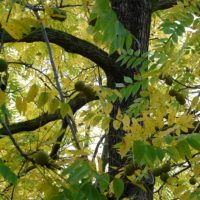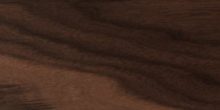
Black Walnut (Juglans nigra)
American black walnut, also called Eastern black walnut and American walnut, is a sought-after species known for its attractive figuring and wide variations in color.
Appearance

American walnut
Black walnut is usually rich and dark, though it can display considerable variation in color. The heartwood (wood taken from the center of the tree) ranges from a pale brown to a dark coffee color, sometimes with a gray or purple tint. The outer wood – sapwood – ranges from off-white to yellowish gray. Because there is frequently high tone contrast between the heartwood and sapwood, black walnut is often steamed to create greater uniformity.
In addition to notable variation in color, black walnut also displays a wide variety of grain patterns. Graining is usually thin and straight, though waviness and curling also occur. Knots, checks, splits, piths and mineral streaks are common – so much so that hardwood grading standards have been adjusted slightly to account for these “imperfections” within the species. Given these natural features and the narrow trunk diameter, Black walnut planks tend to be narrow.
While black walnut is probably a poor choice for those who seek a uniform look, many homeowners seek out “character grade” walnut – lumber selected for its attractive natural patterning. Character grade walnut is an especially appealing choice for those looking for a more rustic look.
Wood derived from walnut burls – knotty growths that occur naturally on the tree’s roots, trunk and branches – is highly coveted by woodworkers for its unique grain patterns and natural resistance to splits. As it is often quite costly and difficult to work, walnut burl is often reserved for inlays and veneers.
Durability
On the Janka scale – the system of measuring a wood’s hardness – black walnut has a rating of 1010, making it a moderately hard wood. It is somewhat softer than other domestic hardwoods such as oak and maple, so care should be taken to protect high traffic areas. Black walnut is fairly resistant to warping and decay, and so is suitable for both indoor and outdoor applications. It takes finish easily and evenly.
Availability
Black walnut is native to North American and is prevalent throughout the northern United States and Canada. It is widely available and considered a sustainable material. Given its attractive grain patterns and popularity for a variety of woodworking applications, black walnut tends to be somewhat expensive for a domestic species. It is easy to work with, though, which can help reduce labor costs.
Peruvian Walnut (Juglans peruviana)
Peruvian walnut, also known as nogal, is a species in the same genus as black walnut, with many similar traits. Despite its name, Peruvian walnut can actually be found throughout South America and as far north as Mexico. For those attracted to the character of black walnut but seeking wider planks and greater consistency, this exotic species makes a fine alternative.
Appearance

Peruvian walnut
Peruvian walnut is slightly darker than domestic walnut. It is chocolate-colored, often with a slightly purple tint. Its grains are generally straighter and more consistent. Its texture is slightly coarser and more porous than black walnut, and it has an attractive natural sheen.
Durability
Peruvian walnut is slightly softer than its American cousin. It has a Janka rating of 960. Despite this, it is still fairly resistant to warping and decay and is suitable for some outdoor uses. It is easy to work and takes finish evenly. As with black walnut, care should be taken to protect high traffic areas.
Availability
Because Peruvian walnut is prized for its workability and attractiveness, it has unfortunately been overharvested. Though efforts are underway to grow its population, this limited availability has reduced its commercial availability. Peruvian walnut lumber can still be obtained from existing supplies, though there is currently a moratorium on exports to the United States. This has contributed to higher costs, making it more expensive than its domestic counterpart. Despite this, Peruvian walnut is still considered moderately priced for an exotic species.
Natural Character
The dark, rich tones and handsome graining of American black walnut and Peruvian walnut make them attractive choices for wood floors, inlays and accents. Natural variations within the species give both species unique dimension and character. At Oshkosh Designs, we hand-select every piece of wood to ensure our clients get the finest quality and the most attractive floors possible.



